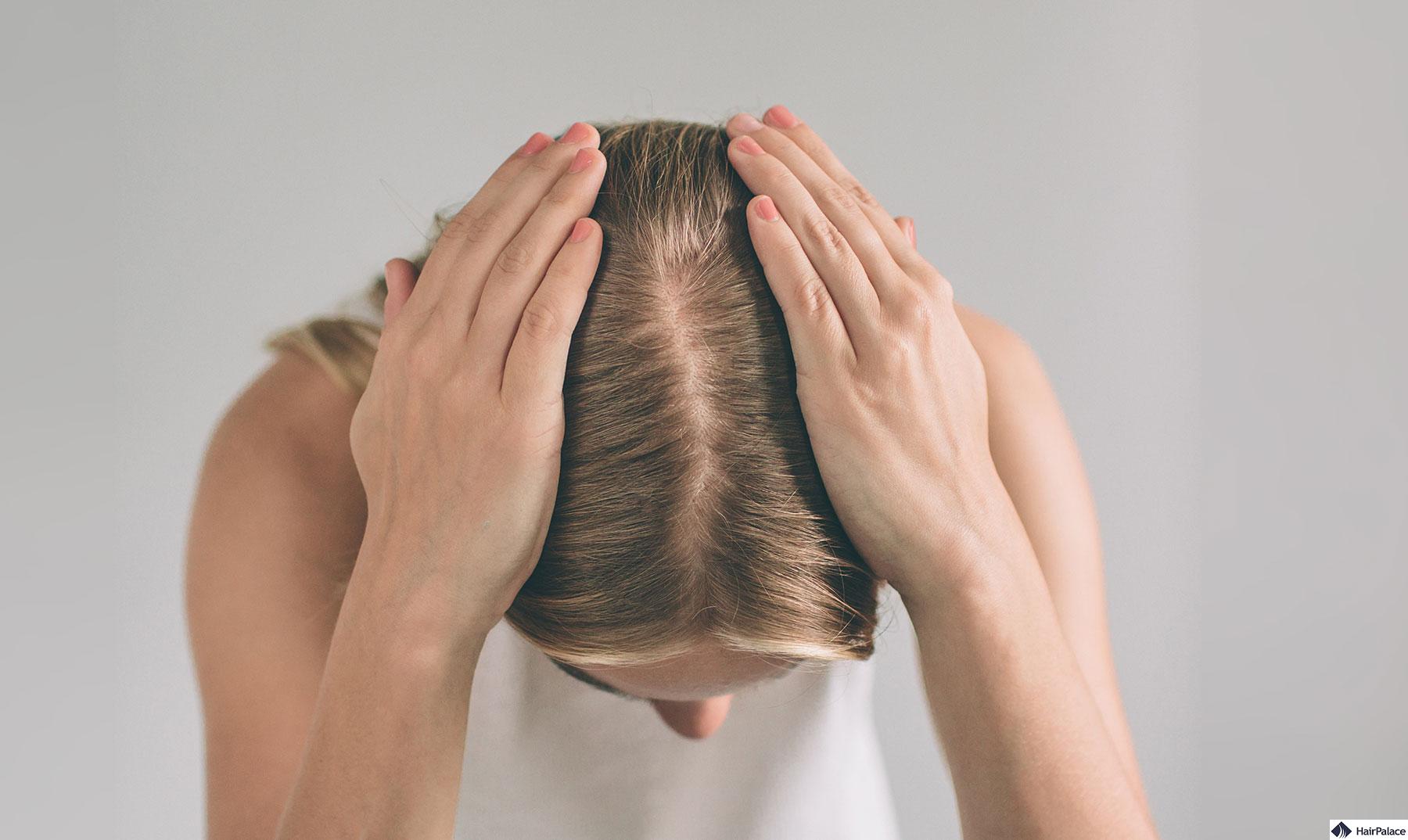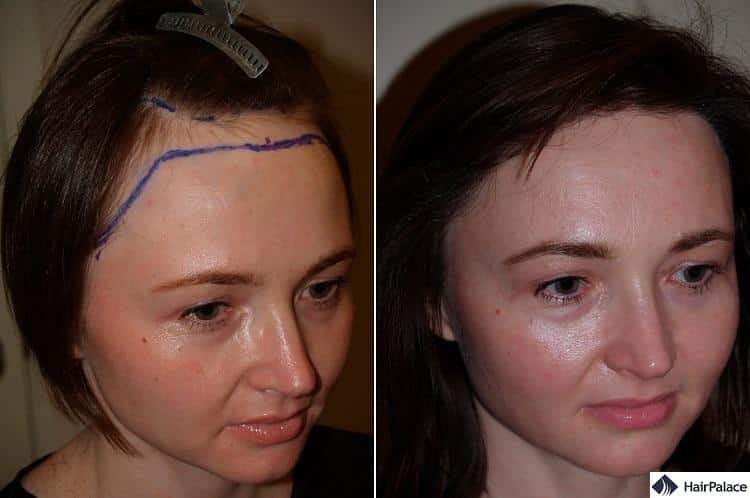Hair Transplant Women: Is it The Best Choice?

There are many different reasons why your hair is falling out and while some are easily fixed, others might require professional help.
If your hair loss is particularly severe, and you’re worried about going completely bald, you might be curious about permanent solutions, like hair transplantation surgery.
Is hair replacement for women a good option?
In this article, we’ll help answer all your questions about female hair loss.
We’ll also explore whether hair transplantation surgery is the right choice for you.
- Female hair loss
- Female hair transplant
- Who is a good candidate?
- Female hair transplant cost
- Results
- Alternatives
- Takeaway
What causes female hair loss?
Statistics show that only one in three women will experience hair loss. In the majority of cases, women will only lose their hair temporarily. Phew!
But remember, the hair will only grow back once you remedy the root cause.
Common causes of hair loss in women include:
- Hormonal changes
- Significant life events, including pregnancy and menopause
- Suffering from depression, stress, or anxiety
- As a side-effect of medication
- Excessive use of heat styling tools like curling irons, straighteners, or hair dryers
- Wearing tight hairstyles like buns, cornrows, or braids
- Suffering from an allergic reaction
- Wearing hair extensions for prolonged periods
- Genetic conditions like androgenetic alopecia
- Applying harsh chemical treatments, such as peroxide or perms
- Vitamine deficiencies
- Physical trauma to your scalp
You should consult with a professional as soon as possible for a formal diagnosis. This often begins with an online consultation and questionnaire.
Your doctor will closely inspect your scalp and may conduct several tests to gather additional information.
Once they are confident they’ve identified the source, appropriate treatment may begin.
Though rare, women who suffer from extensive hair loss can undergo a hair transplant; this procedure offers a permanent, highly effective solution.
The difference between male and female hair loss and hair transplants
While there are many similarities between how men and women lose hair, there are equally as many differences.
These differences are why women aren’t often ideal candidates for hair implants.
There are two differences in particular that you should know about:
The type of donor hair
A hair transplant relies on taking donor hair (usually on the back and sides) and redistributing it into balding areas.
Research suggests that only 2-5% of women are eligible candidates for hair transplants because they have unsuitable donor hair.
In men, donor hair is often resistant to hair loss, making it an ideal resource for your surgeon to harvest.
When implanted, they will resist harmful hormones like dihydrotestosterone (DHT) and continue to grow.
Unfortunately for women, these donor sites experience the same hair loss as the rest of the scalp.
This means that when you implant these already vulnerable hairs, they are highly likely to fall out, defeating the purpose of the transplant.
Men’s vs Women’s hairline transplant
Another striking difference between men’s and women’s hair is the hairline.
Especially with genetic conditions like pattern baldness, men lose their hair entirely differently than women.
And hair transplants can only really address the man’s needs, not the woman’s.
In men, baldness typically begins at the temples. As the hairline recedes, it creates a distinguished “M” shape on the crown of the head.
Over time, hair loss extends to such a degree that the top of the scalp is entirely bald while the sides and back of the head still retain hair.
In contrast, women don’t necessarily lose hair.
Rather experience overall thinning throughout the scalp. Their hair part may also begin to widen. Unfortunately, hair transplants do not address “volume” issues.
It’s not all bad for women, though. Although hair transplants are often unsuitable, women tend to respond better to alternative therapies for hair loss than men.
These include medication, laser therapy, and lifestyle changes. Women often experience thinning hair instead of partial or total hair loss.

Hair transplant for women
Despite the low number, many women still undergo a hair transplant yearly.
Because women only make up a minority of patients for hair implants, it’s essential that you only visit a surgeon who is well-trained and highly experienced with female hairlines.
Depending on the extent of your hair loss, a hair transplant for women in the UK can take one of two routes:
FUT hair transplant women
Follicular Unit Transplantation (FUT) is when a small strip of flesh is removed from the back or side of your head.
This strip will have healthy hair follicles harvested and implanted into balding areas.
FUT surgery has two disadvantages: the strip method will leave noticeable scars across the donor area. And because it is invasive, the procedure will require a longer recovery time.
FUE hair transplant women
Follicular Unit Extraction (FUE) is a modern approach to hair transplantation.
Instead of removing a strip of flesh, your surgeon will harvest hair follicles individually from the donor area and strategically implant them into bald spots.
A FUE hair transplant for female patients is by far the most popular and preferred method because it promises high-quality, natural-looking results, a shorter recovery period, and no visible scars.
What’s the best hair transplant for female pattern baldness?
The best technique for women hair transplant surgery is generally the Follicular Unit Extraction (FUE) method, as it allows for precise placement of hair follicles and minimal scarring.
However, you should keep in mind that a female hair transplant is generally less effective than its male counterpart, regardless of the technique you choose.
Who is a good candidate for a hair transplant procedure?
Every patient is unique, and you won’t know if you’re an ideal candidate for hair implants until you attend a consultation.
That said, women who suffer from the following will often benefit the most from the procedure:
- Women whose hair loss is a result of physical trauma (like traction alopecia), or injury
- Women whose hair loss is a result of other plastic surgery
- Women with symptoms of female pattern baldness
Female hair transplant UK cost
The average female hair transplant cost ranges between £3,000-£10,000.
But various factors can influence this figure, including the extent of your hair loss and the amount you are getting transplanted.
You should also factor hair clinic’s reputation and experience, too.
Clinics with highly skilled surgeons may cost a premium, but it’s a price worth paying for better treatment.
You can get an accurate picture of current hair transplant surgery costs by booking an online consultation with a reputable clinic.
Many of these are free, so you have nothing to lose.
Not only that, many clinics offer competitive payment plans to help you get the treatment you need.
Female hair transplant results
Alternative ways to treat female hair loss
Hair transplantation is not the only remedy for female hair loss, so don’t be discouraged if you are told you’re an unsuitable candidate.
Alternative hair loss treatments may prove even more effective in most cases.
Below we will highlight some of the best treatments you should consider.
- Minoxidil (Rogaine): It comes in two forms, topical and foam, and is said to stimulate hair regrowth and speed up your hair’s natural growth cycle.
- Laser therapy: Low-level laser therapy (LLLT) works by irritating photons into your scalp tissue, softening the skin, and boosting blood flow to hair follicles.
- Corticosteroids: Corticosteroids are anti-inflammatory drugs that are particularly effective at treating a range of autoimmune conditions like alopecia areata.
- Platelet Rich Plasma (PRP): PRP therapy uses platelets from your blood supply and injects them directly into areas of your scalp that are balding. This is believed to stimulate hair growth.
- Hormone therapy: The treatment restores estrogen and progesterone levels, alleviating the severity of hot flushes and night sweats but helping retain your normal hair condition.
- Scalp massages: Some studies claim that physical therapies like scalp massages can help increase blood circulation in the area, allowing your hair follicle to receive all the nutrients it needs to grow strong.
- Balanced diet: Hair loss can be a side-effect of a poor diet. Your body lacks the minerals and vitamins needed to sustain hair growth. To counter this, aim to eat foods rich in protein and vitamins.
- Hair loss shampoos: There are a variety of highly effective medicated shampoos on the market that aim to support your hair, nourish your skin, and remove dead skin cells.
Conclusion
From stress and hormonal changes to extreme hairstyling, chemical treatments, and female pattern baldness, there are many reasons why a woman might start to lose her hair.
Thankfully, the effects of hair loss are not as severe as are often found in men.
Unfortunately, only around 2-5% of women will see results after a hair transplant.
In most cases, it is much more beneficial to try alternative treatments such as medication or hormone therapy.
That being said, female hair transplant surgery can potentially remedy the most severe hair loss cases.
That’s why visiting your local GP can be incredibly important.
You will find the root cause of your hair loss and get recommendations on the most appropriate hair loss treatment for your unique situation.
Hair Transplant Women FAQ
The answer is – yes! Although they make up a much smaller number of patients, a female hair transplant can still be viable if you have the right kind (and quantity) of donor hair.
A hair transplant is a permanent solution to hair loss. You can expect the transplanted hair to grow for life!
But you must be patient. New hair will grow three months after your procedure. Six months on, this hair will blend perfectly with your existing hair to create a natural-looking, thicker head of hair.
This ultimately depends on the type of procedure you are undergoing and the extent of your hair loss. If you are undergoing a FUT procedure, your hair does not need to be shaved.
With an FUE procedure, your surgeon may shave all or only parts of your hair, depending on the severity of hair loss. Shaving your hair gives the surgeon maximum scalp visibility, allowing them to implant hairs more accurately.
The average female hair transplant cost ranges between £3,000-£10,000.
Women can undergo hair transplants, but it’s often not recommended. Unlike male pattern baldness, there isn’t a stable donor area for extracting hair follicles. As a result, the surgeon cannot ensure lasting results, and the transplanted hairs may eventually shed.
Last medically reviewed on March 4th, 2025
- Barbareschi M. The use of minoxidil in the treatment of male and female androgenetic alopecia: a story of more than 30 years. G Ital Dermatol Venereol. 2018 Feb;153(1):102-106. doi: 10.23736/S0392-0488.17.05781-9. PMID: 29319278.https://pubmed.ncbi.nlm.nih.gov/29319278/
- McElwee KJ, Shapiro JS. Promising therapies for treating and/or preventing androgenic alopecia. Skin Therapy Lett. 2012 Jun;17(6):1-4. PMID: 22735503.https://pubmed.ncbi.nlm.nih.gov/22735503/
- Lam SM. Hair Loss and Hair Restoration in Women. Facial Plast Surg Clin North Am. 2020 May;28(2):205-223. doi: 10.1016/j.fsc.2020.01.007. PMID: 32312508.https://pubmed.ncbi.nlm.nih.gov/32312508/
- Birch MP, Lalla SC, Messenger AG. Female pattern hair loss. Clin Exp Dermatol. 2002 Jul;27(5):383-88. doi: 10.1046/j.1365-2230.2002.01085.x. PMID: 12190638.https://pubmed.ncbi.nlm.nih.gov/12190638/






